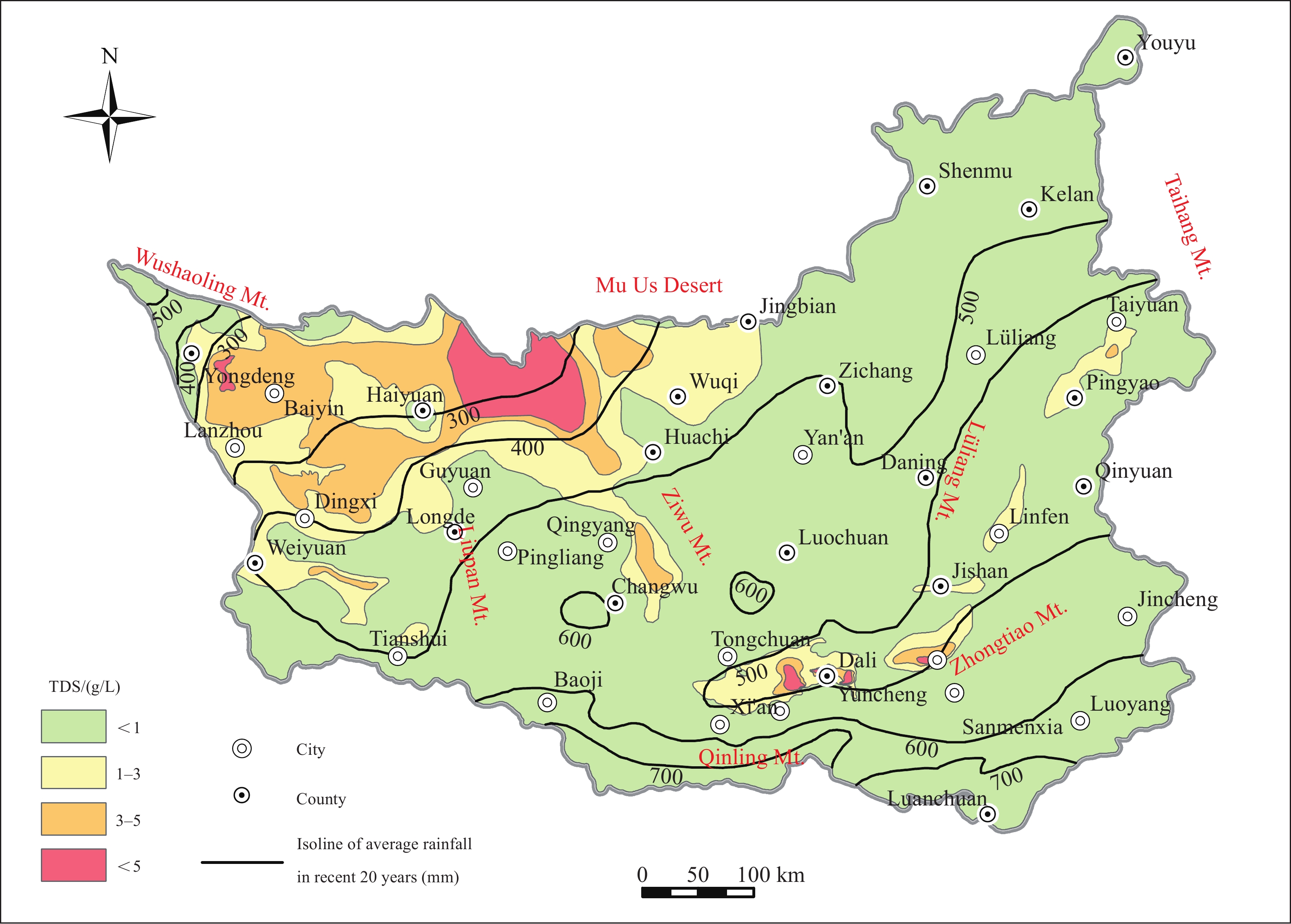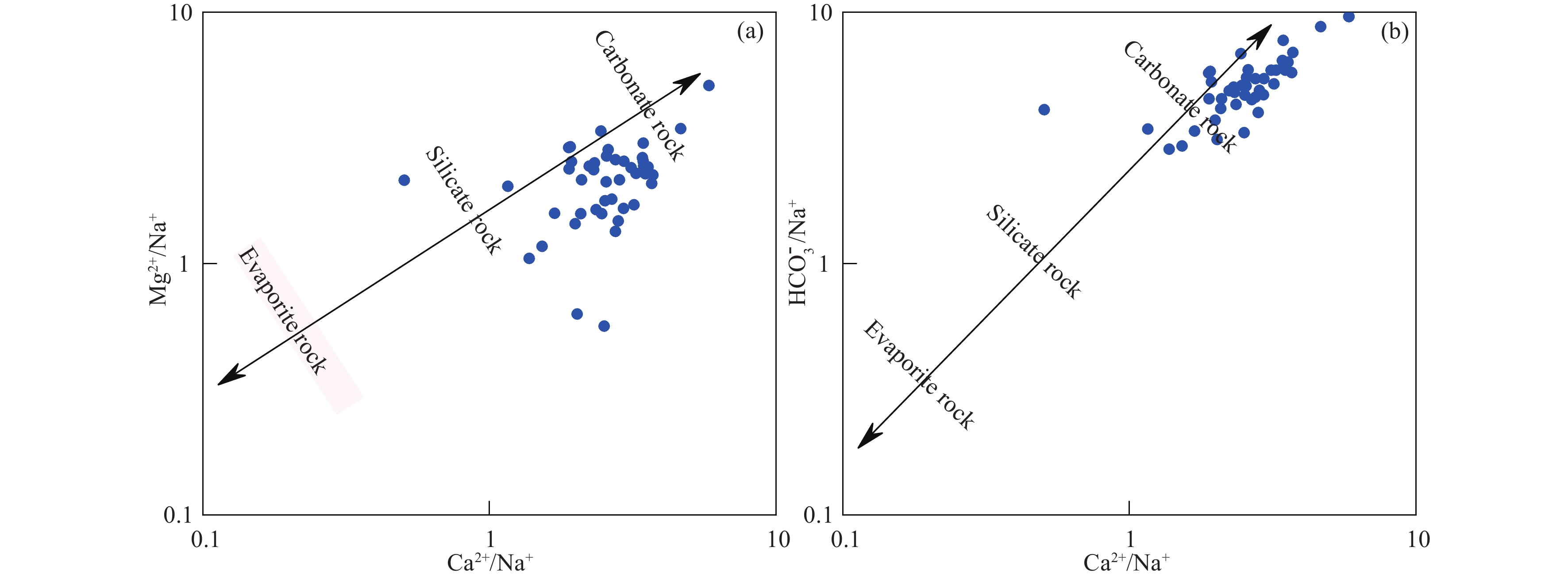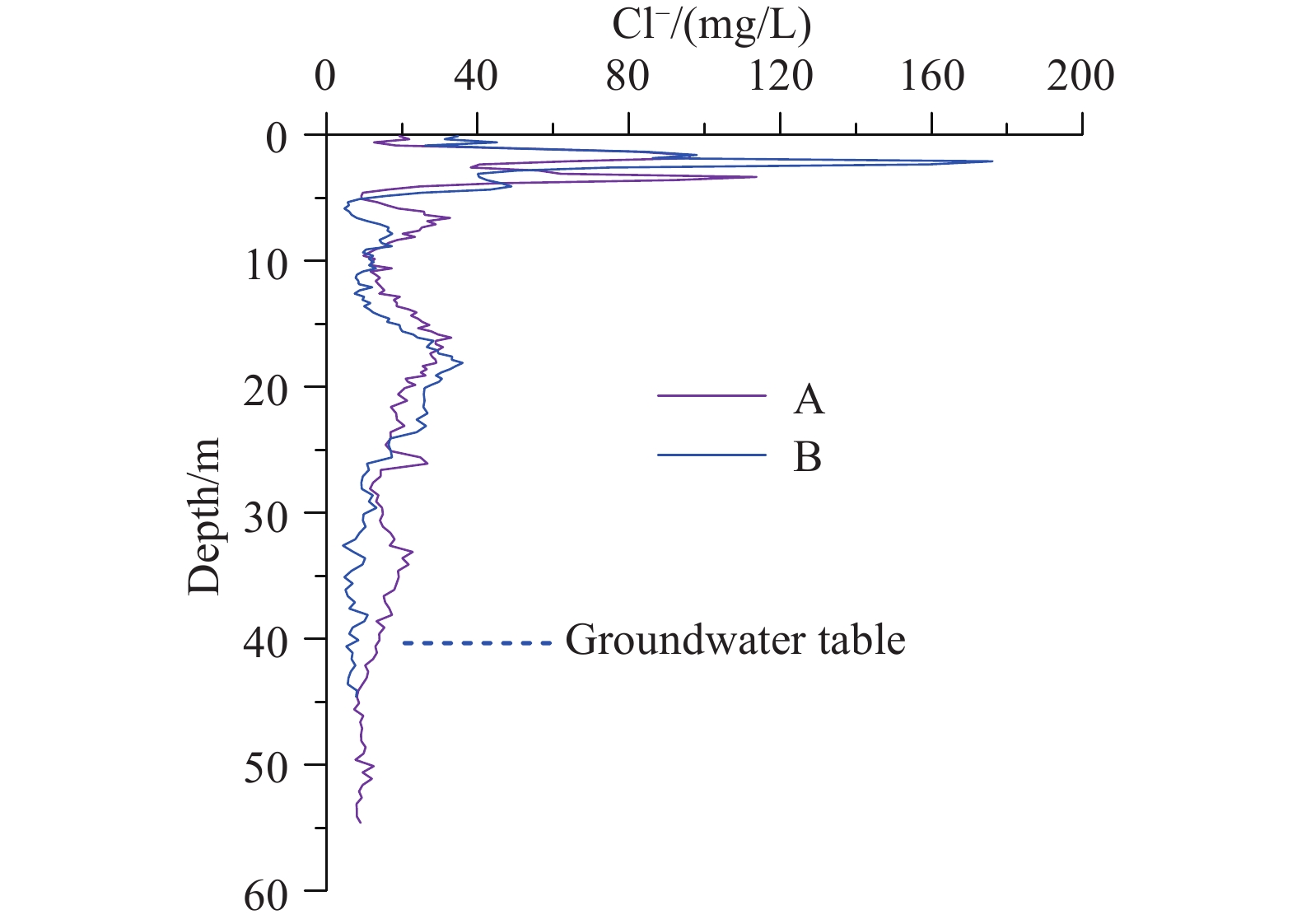| Citation: | Hai-xue Li, Shuang-bao Han, Xi Wu, Sai Wang, Wei-po Liu, Tao Ma, Meng-nan Zhang, Yu-tao Wei, Fu-qiang Yuan, Lei Yuan, Fu-cheng Li, Bin Wu, Yu-shan Wang, Min-min Zhao, Han-wen Yang, Shi-bo Wei, 2021. Distribution, characteristics and influencing factors of fresh groundwater resources in the Loess Plateau, China, China Geology, 4, 509-526. doi: 10.31035/cg2021057 |
Distribution, characteristics and influencing factors of fresh groundwater resources in the Loess Plateau, China
-
Abstract
The fresh groundwater in the Loess Plateau serves as a major source of water required for the production and livelihood of local residents and is greatly significant for regional economic and social development and ecological protection. This paper analyzes the hydrogeological conditions and groundwater characteristics in the Loess Plateau, expatiates on the types and distribution characteristics of the fresh groundwater in the plateau, and analyzes the influencing factors and mechanisms in the formation of the fresh groundwater in the plateau as a priority. Based on this, it summarizes the impacts of human activities and climatic change on the regional fresh groundwater. The groundwater in Loess Plateau features uneven temporal-spatial distribution, with the distribution space of the fresh groundwater closely relating to precipitation. The groundwater shows a distinct zoning pattern of hydrochemical types. It is fresh water in shallow parts and is salt water in deep parts overall, while the fresh water of exploration value is distributed only in a small range. The storage space and migration pathways of fresh groundwater in the loess area feature dual voids, vertical multilayers, variable structure, poor renewability, complex recharge processes, and distinct spatial differences. In general, the total dissolved solids (TDS) of the same type of groundwater tends to gradually increase from recharge areas to discharge areas. Conditions favorable for the formation of fresh groundwater in loess tablelands include the low content of soluble salts in strata, weak evaporation, and special hydrodynamic conditions. Owing to climate change and human activities, the resource quantity of regional fresh water tends to decrease overall, and the groundwater dynamic field and the recharge-discharge relationships between groundwater and surface water have changed in local areas. Human activities have a small impact on the water quality but slightly affect the water quantity of the groundwater in loess.
-

-
References
Cheng LP, Liu WZ, Li Z, Han XY. 2016. Land use change affects groundwater recharge in the Changwu Loess Tableland of China. Advances in Water Science, 27(5), 670–678 (in Chinese with English abstract). doi: 10.14042/j.cnki.32.1309.2016.05.004. Fei J. 1996. The direction for further study on fresh groundwater resource management. Earth Science Frontiers, 4(2), 156–160 (in Chinese with English abstract). Gates JB, Scanlon BR, Mu XM, Zhang L. 2011. Impacts of soil conservation on groundwater recharge in the semi-arid loess plateau, China. Hydrogeology Journal, 19, 865–875. Han SB, Li FC, Wang S, Li HX, Yuan L, Liu JT, Shen HY, Zhang XQ, Li CQ, Wu X, Ma T, Wei SB, Zhao MM. 2021. Groundwater resource and eco-environmental problem of the Yellow River Basin. Geology in China, 48(4), 1001–1019 (in Chinese with English abstract). doi: 10.12029/gc20210402. Hou GC, Yin LH, Xu DD. 2017. Hydrogeology of the Ordos Basin, China. Journal of Groundwater Science and Engineering, 5(2), 104–115. Hu PF, Li J, Zhang YL, Zhu GF, He PX, Cao YP. 2019. Temporal and spatial variation and influencing factors of water storage on the Loess Plateau. Remote sensing technology and application, 34(1), 176–186 (in Chinese with English abstract). doi: 10.11873/ji.ssn.1004‒0323.2019.1.0176. Hu W, Wang YQ, Li HJ, Huang MB, Hou MT, Li Z, She DL, Si BC. 2019. Dominant role of climate in determining spatiotemporal distribution of potential groundwater recharge at a regional scale. Journal of Hydrology, 578, 124042. Huang TM, Pang ZH, Liu JL, Ma JZ, Gates JB. 2017. Groundwater recharge mechanism in an integrated tableland of the Loess Plateau, northern China: Insights from environmental tracers. Hydrogeology Journal, 25(7), 2049–2065. doi: 10.1007/s10040-017-1599-8. Huang TM, Pang ZH. 2011. Estimating groundwater recharge following land-use change using chloride mass balance of soil profiles: A case study at Guyuan and Xifeng in the Loess Plateau of China. Hydrogeology Journal. 19(1), 177–186. Huang TM, Ma BQ, Pang ZH, Li Z, Li ZB, Long Y. 2020. How does precipitation recharge groundwater in loess aquifers? Evidence from multiple environmental tracers Journal of Hydrology, 583, 124532. Huang TM, Pang ZH, Edmunds WM. 2013. Soil profile evolution following land -use change: Implications for groundwater quantity and quality. Hydrological Processes, 27(8), 1238–1252. Huang YN, Evaristo J, Li Z. 2019. Multiple tracers reveal different groundwater recharge mechanisms in deep loess deposits. Geoderma, 353, 204–212. Ji JF, Chen J, Wang HT. 1997. Crystallinity of illitefrom the Luochuan loess-paleosol sequence, Shaanxi Province-Indicators origin and paleoclimate of loess. Geological Review, 4(2), 181–185 (in Chinese with English abstract). Li F, Zhang MS, Zhao J, Zhang SS, Sun PP, Gu TF, Liu XB, Lin H, An ZS, Peng JB, Li G. 2021. The genesis, development, and evolution of original vertical joints in loess. Earth-Science Reviews, 214, 103526. Li HX, Cheng XX, Ma YK, Liu WP, Zhou B. 2021. Characteristics and formation mechanism of strontium-rich groundwater in Malian River drainage basin, Southern Ordos Basin. Geoscience, 35(3), 682–692 (in Chinese with English abstract). doi: 10.19657/j.geoscience.1000-8527.2020.037. Li P, Li TL, Wang AD, Zhang YG, Liang Y, Zhao JF. 2013. In-situ test research on regularities of water migration in loess. Rock and Soil Mechanics, 34(5), 1331–1339 (in Chinese with English abstract). doi: 10.16285/j.rsm.2013.05.041. Li Q. 2015. Mechanism of groundwater response to climate change in Weihe River basin. Xi’an, Chang’an University, 58‒66 (in Chinese with English abstract). Li Z, Coles AE, Xiao J. 2019a. Groundwater and streamflow sources in China’s Loess Plateau on catchment scale. Catena, 181, 104075. Li Z, Xiao J, Evaristo J. 2019b. Spatio-temporal variations in the hydrochemical characteristics and controlling factors of streamflow and groundwater in the Wei River of China. Environmental Pollution, 254. Li Z, Li CX, Hua K, Li Z. 2019. Groundwater chemistry characteristics and the analysis of influence factors in the Luochuan Loess tablelands. Environmental Science, 40(8), 3559–3567. doi: 10.13227/j.hjkx.201809131. Lin XY, Wang JS. 2006. Groundwater Resources and Its Renewal Capability Research in Yellow River Catchment. Zhengzhou, Yellow River Water Conservancy Press, 1‒159 (in Chinese). Ling XY, Ma JZ, Chen PY, Yu HC. 2021. Hydrogeochemical characteristics and radiocarbon dating of groundwaterin the Dongzhi Tableland of Longdong Loess Plateau. Journal of Lanzhou University: Natural Sciences, 57(1), 24–32 (in Chinese with English abstract). doi: 10.13885/j.issn.0455-2059.2021.01.004. Liu DS, Sun JM, Wu WX. 2001. Past, present and future of the Chinese loess research: A discussion on the reality of facts and myth. Quaternary Sciences, 21(3), 185–207. Liu DS. 1964. Loess in the Middle Reaches of the Yellow River Basin. Beijing, SciencePress, 156–159 (in Chinese). Liu X, Xiang W, Si BC. 2021a. Hydrochemistry and its controlling factors and water quality assessment of shallow groundwater in the Wei and Jing River catchments. Environmental Science, 42(6), 2817–2825 (in Chinese with English abstract). Liu X, Xiang W, Ma XJ, Fan YL, Si BC. 2021b. Hydrochemical characteristics and controlling factors of shallow groundwater along the Yellow River in the middle of the Chinese Loess Plateau. China Environmental Science, (in Chinese with English abstract). Lu YR. 2014. Build ecological civilization and protect groundwater resources to promote sustainable development and utilization. Acta Geoscientica Sinica, 35(2), 129–130. doi: 10.3975/cagsb.2014.02.01. Ma ZY, Yun ZH, Li XC, Zou JF, Hou C, Wan WF. 2014. Recognition on recharge of Shaizhudong spring in the central Weibei, Shaanxi Province, China. Carsologica Sinica, 33(2), 136–145 (in Chinese with English abstract). Pan F, Zhang QH, He JH. 2014. Groundwater recharge environment and geochemistry evolution of the Quaternary aquifer in the Dunzhiyuan region, Gansu Province. Arid Land Geography, 37(1), 9–18 (in Chinese with English abstract). doi: 10.13826/j.cnki.cn65-1103/x.2014.01.011. Pang ZH, Huang TM, Yang S, Yuan LJ. 2018. The potential of the unsaturated zone in groundwater recharge in arid and semiarid areas. Journal of Engineering Geology, 26(1), 51–61 (in Chinese with English abstract). doi: 10.13544/j.cnki.jeg.2018.01.006. Sun JZ. 2005. Loess. Hong Kong, Archaeological Society of Hong Kong, 21‒24 (in Chinese). Sun YB, Liu PF, Wang WK, Liu SL. 2016. Chemical characteristics and formation mechanism of groundwater in Wei River Basin. South-to-North Water Transfers and Water Science and Technology, 14(2), 152–158 (in Chinese with English abstract). doi: 10.13476/j.cnki.nsbdqk.2016.02.027. Sun YB, Wang WK, Duan L, Zhang CC, Wang YH. 2014. Geochemistry evolution mechanism of shallow groundwater in the Guanzhong Basin, China. Hydrogeology and Engineering Geology, 41(3), 29–35 (in Chinese with English abstract). doi: 10.16030/j.cnki.issn.1000-3665.2014.03.005. Tao H, Tao FP, Liu WB. 2013. An in-situ method for determining shear strength parameters of rock masses and a study of the related test results. Hydrogeology and Engineering Geology, 40(6), 37–42, 61 (in Chinese with English abstract). doi: 10.16030/j.cnki.issn.1000-3665.2013.06.017. Tao H, Zheng MM, Fan LM, Li WL, Ding J, Li H, He XB, Tao FP. 2017. Research on quality changes and influencing factors of groundwater in the Guanzhong Basin. Journal of Groundwater Science and Engineering, 5(3), 296–302. Wada Y. 2015. Modeling groundwater depletion at regional and global scales: Present state and future prospects. Surveys in Geophysics. 37 (2), 419–451. Wan H, Liu WG. 2016. An isotope study (δ18O and δD) of water movements on the Loess Plateau of China in arid and semiarid climates. Ecological Engineering, 93, 226–233. Wang R, Liu WZ, Li LX. 2014. Effect of land use types on the deep soil moisture of the loess tableland- A case of Changwu. Journal of Arid Land Resources and Environment, 28(11), 127–132 (in Chinese with English abstract). doi: 10.13448/j.cnki.jalre.2014.11.022. Wang SH, Hu XL, Lan YC, Wang J, Ding ZS. 2009. Bitter-Salty Water Resources Amount and its Distribution in Gansu Province. Journal of Desert Research, 29(5), 995–1001 (in Chinese with English abstract). Wang Y, Chen RS, Guo CH, Xia ZL. 2021. Study on the pattern change and regional differentiation of resources and environment in the Yellow River Basin and suggestions on eco-geological suvey. Geology in China, 48(1), 1–20 (in Chinese with English abstract). doi: 10.12029/gc20210101. Wang WK, Gong CC, Zhang ZY, Chen L. 2018. Research status and prospect of the subsurface hydrology and ecological effect in arid regions. Advances in Earth Science, 33(7), 702–718 (in Chinese with English abstract). doi: 10.11867/j.issn.1001-8166.2018.07.0702. Wang YR, Zhang Q, Jiang SB. 2011. A review of recent study advances in climatic environment on China Loess Plateau. Advances in Meteorological Science and Technology, 1(2), 38–42 (in Chinese with English abstract). Wang YS, Li S, Li HX, Cheng XX, Liu WP, Zhang MN. 2019. Groundwater salinization characteristics and controlling factors in the Haiyuan Basin. Hydrogeology and Engineering Geology, 46(4), 10–17, 57 (in Chinese with English abstract). doi: 10.16030/j.cnki.issn.1000-3665.2019.04.02. Wang ZH, Liang YP, Tang CL, Shen HY, Zhao CH, Guo FF, Xie H, Zhao Y. 2020. Ecological restoration pattern and quantitative evaluation of recirculation measures for northern discontinuous karst spring: A case study of Jinci Spring in Taiyuan City, Shanxi Province. Geology in China, 47(6), 1726–1738 (in Chinese with English abstract). doi: 10.12029/gc20200610. Wen QZ. 1989. The Loess Geochemistry in China. Beijing, Science Press, 36–42. Wu AM, Hao AB, Guo HP, Liu JA, Zhang EY, Wang H, Wang XF, Wen XR, Zhang CG. 2020. Main progress and prospect for China's hydrogeological survey. Journal of Groundwater Science and Engineering, 8(3), 195–209. Xie Y, Wang J, Li MH, Jiang XS, Xie ZW, Luo JN, Hou GC, Liu F, Wang DQ, Sun YM, Cao JK, Zhu H, Wang YH. 2004. Relations of the Early Cretaceous lithofacies paleogeography to groundwater quality and distribution in the Ordos basin. Geological Bulletin of China. 23(11), 1094–1102 (in Chinese with English abstract). Xiong LY, Tang GA, Strobl J, Zhu AX. 2016. Paleotopographic controls on loess deposition in the Loess Plateau of China. Earth Surface Processes and Landforms, 41(9), 1155–1168. Xu XX, Zhang BY, Tian JL. 2010. Experimental study on the precipitation-soil water-groundwater transformation in loess hilly region. Advances in Water Science, 21(1), 16–22 (in Chinese with English abstract). doi: 10.14042/j.cnki.32.1309.2010.01.023. Yan TB, Wang DQ. 1983. The recharge mechanism of unconfined groundwater in the loess of the Luochuanyuan and its water-bearing characteristics. Geological Review, 4(5), 418–427. Yang S, Liu JL, Li Z, Huang TM. 2016. How much information can soil solute profiles reveal about groundwater recharge? Geoscience journal. doi: org/10.1007/s12303-015-0069-3. Zhang CL, Li P, Li TL, Zhang MS. 2014. In-situ observation on rainfall infiltration in loess. Journal of Hydraulic Engineering, 45(6), 728–734 (in Chinese with English abstract). doi: 10.13243/j.cnki.slxb.2014.06.012. Zhang RQ, Liang X, Jin MG, Wan L, Yu QC. 2011. Foundametals of Hydrogeology. Beijing, Geological Publishing House, 9–10 (in Chinese). Zhang ZH. 2003. Chinese Loess. Shijiazhuang, Hebei Education Press, 3‒4 (in Chinese). Zheng XY. 2013. Mechanism of Groundwater Response to Climate Change in Guanzhong basin. Xi’an, Chang’an University, 24‒39 (in Chinese with English abstract). Zhu L, Liu JT, Yang MN, Lü XL, Xie F, Wei YT. 2020. Changes and driving factors of groundwater environment in Lanzhou since 1998. Geology in China, 47(6), 1677–1687 (in Chinese with English abstract). doi: 10.12029/gc20200606. Zhu Y, Jia X, Shao M. 2018. Loess Thickness Variations Across the Loess Plateau of China. Surveys in Geophysics, 39(4), 715–727. Zhou ZF, Zheng H, Zhuang C. 2014. Study on the unrecoverable depletion of groundwater resource. Journal of Hydraulic Engineering, 45(12), 1458–1463 (in Chinese with English abstract). doi: 10.13243/j.cnki.slxb.2014.12.009. -
Access History

-
Figure 1.
Generalized hydrogeology of the Loess Plateau, China.
-
Figure 2.
Shallow groundwater TDS distribution and average precipitation contour line between 2000 and 2020 of the Loess Plateau.
-
Figure 3.
Distribution of exploitable fresh groundwater resources.
-
Figure 4.
Conceptual model for the two-component recharge processes (modified from Huang YN et al., 2019). P–precipitation; E–evaporation; T–plant transpiration.
-
Figure 5.
Typical landforms in the Loess Plateau.
-
Figure 6.
Gibbs graphs of loess tableland groundwater.
-
Figure 7.
Relationship between Mg2+/Na+, Ca2+/Na+ and HCO3-/Na+ and Ca2+/Na+ of groundwater in loess tableland area.
-
Figure 8.
Recharge, runoff and discharge conditions of loess groundwater in Dongzhi Tableland.
-
Figure 9.
Chloride distribution in soil water and groundwater (data source: Huang TM, 2020).
-
Figure 10.
Variance of groundwater table in Dongzhi Tableland between 1981 and 2020.
-
Figure 11.
Variance of groundwater table, exploration and precipitation in Dongzhi Tableland.

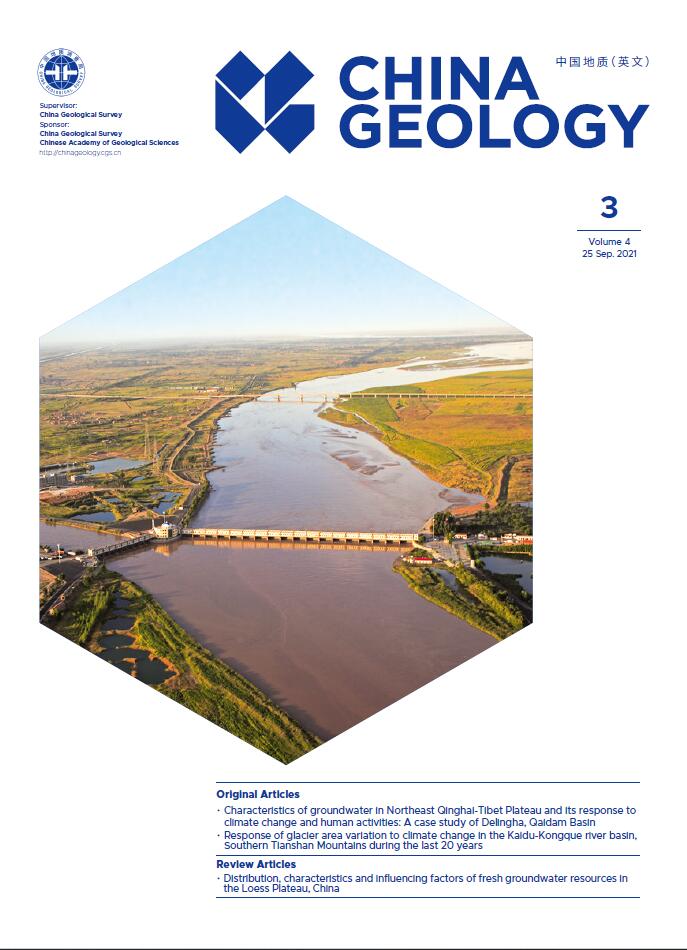

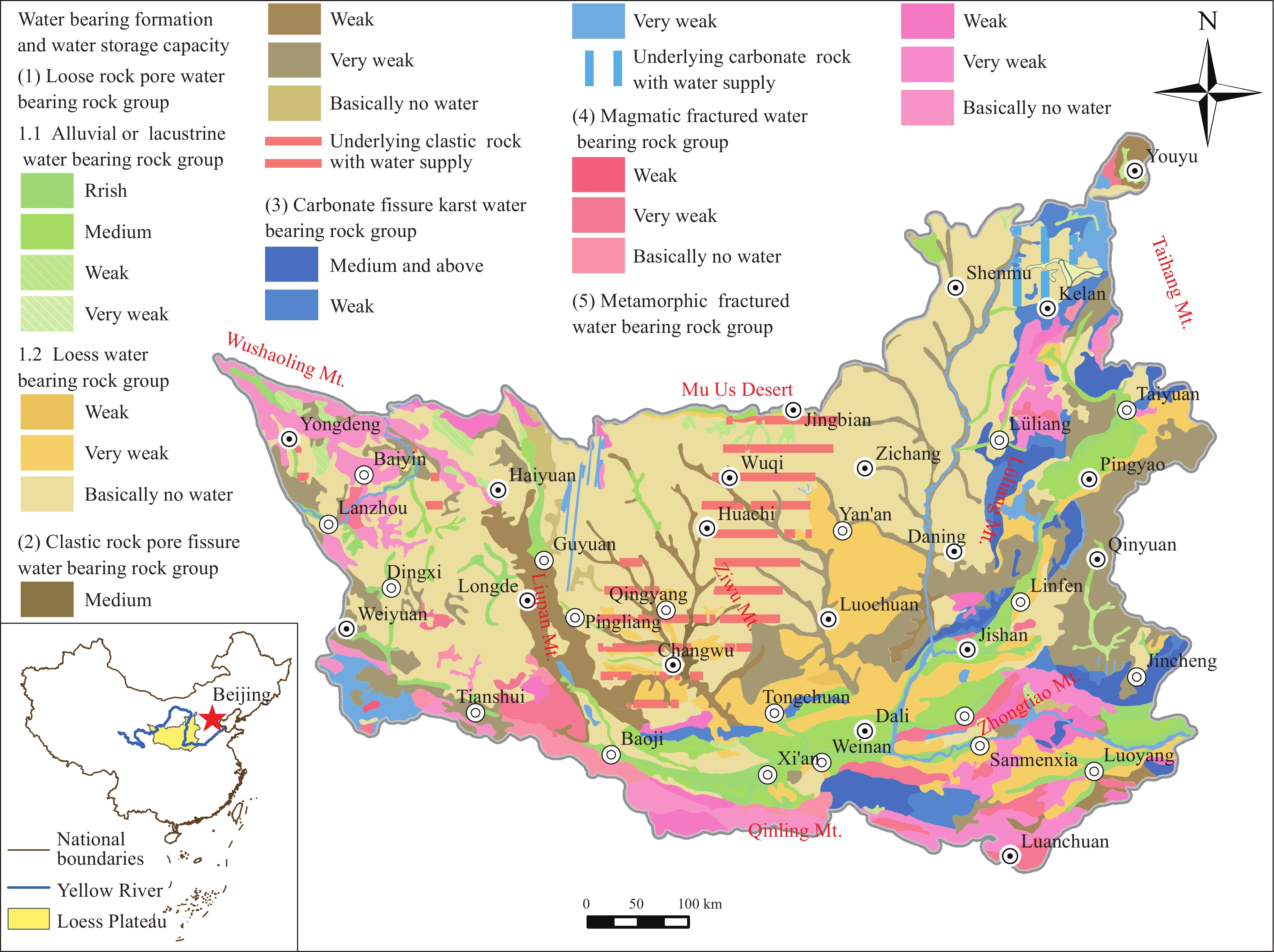

 DownLoad:
DownLoad:
